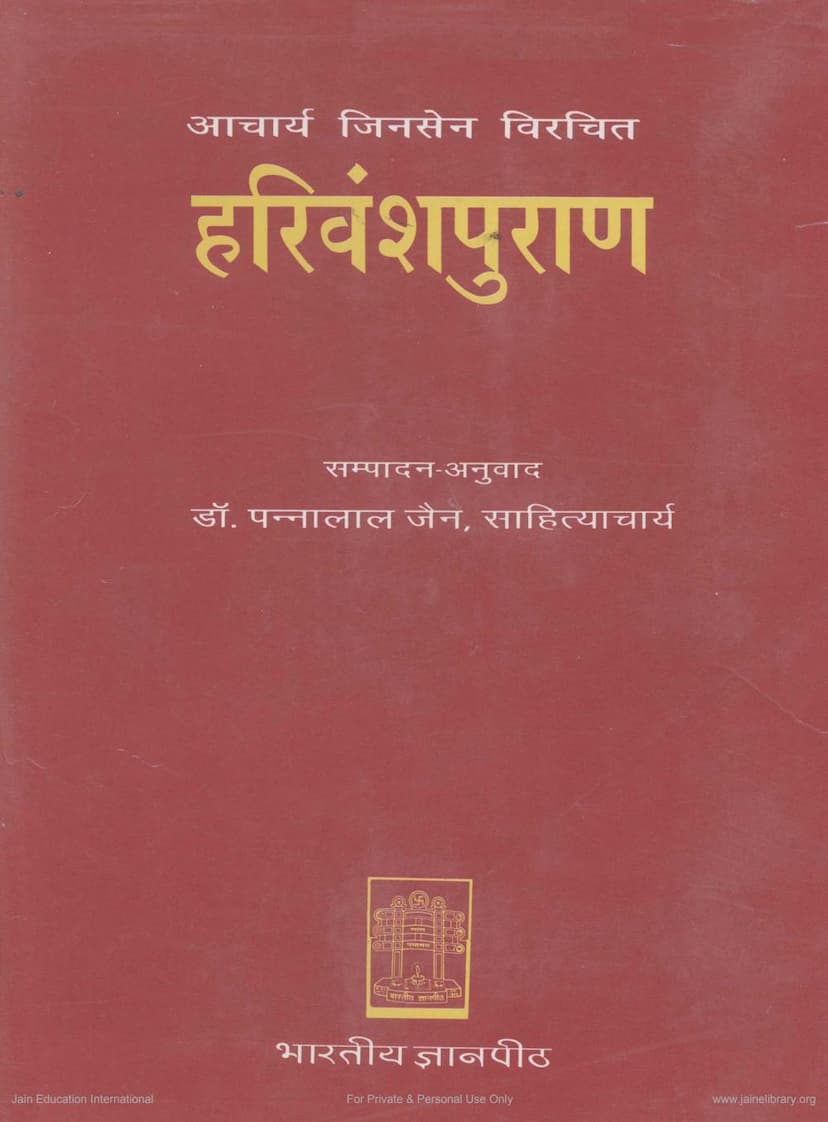Harivanshpuran
Added to library: September 1, 2025

Summary
This is a comprehensive summary of the provided Jain text, the Harivanshpurana, based on the provided pages:
Book Title: Harivanshpurana Author: Acharya Jinsenacharya Editor/Translator: Dr. Pannalal Jain, Sahityacharya Publisher: Bharatiya Gyanpith Series: Moortidevi Jain Granthamala (Sanskrit Grantha No. 27)
Overview:
The Harivanshpurana, composed by the 8th-century Jain scholar Acharya Jinsenacharya, is a monumental Sanskrit poetic work. It intricately narrates the life and renunciation of the 22nd Tirthankara, Neminatha, alongside the popular tales of Krishna, Balabhadra, Krishna's son Pradyumna, and the Pandavas and Kauravas. The text also provides a comprehensive introduction to the entire Harivansha lineage and elaborates on various aspects of Jain Dharma and culture. It is a rich repository of material pertaining to Indian culture and history.
Nature of the Work:
Far from being just a narrative text, the Harivanshpurana is a high-quality epic poem (Mahakavya). It is composed of sixty-six cantos (Sargas) in various meters, containing approximately eight thousand nine hundred verses (Shlokas). This edition, published by Bharatiya Jnanpith, includes the original Sanskrit text, a Hindi translation, an important introduction, and numerous appendices, making it valuable for both lovers of Puranic tales and researchers of Indian culture and history.
Content and Significance:
- Central Figures: The Purana primarily focuses on the 22nd Tirthankara, Neminatha, whose life story is presented as an ideal of renunciation. It also prominently features the lives of Krishna (the 9th Narayana), Balabhadra, Krishna's son Pradyumna, and the epic figures of the Pandavas and Kauravas.
- Cultural and Historical Value: The text is described as a virtual encyclopedia for its time, covering not only narratives but also details of various arts, sciences, and philosophy as appropriate to the context. It provides deep insights into Indian culture and history.
- Jain Perspective: The text highlights the Jain perspective on these popular figures. It explains that figures like Rama and Krishna are considered Shalaka Purushas (distinguished individuals) in Jainism due to their extraordinary virtues and actions, which align with the Jain principles of Veer-Puja (veneration of heroes). The text mentions that 24 such great souls (Tirthankaras) illuminated the path of Dharma through penance and knowledge. It also discusses 65 Shalaka Purushas, including Balabhadras, Narayanas, and Pratinarayanas, who set ideals through their courage and suppression of evil.
- Author's Identity: Acharya Jinsenacharya identifies himself as belonging to the Punnata Sangha, with Keertisena as his guru. He completed this work in the Shak Samvat 705 (8th Century CE). This historical consciousness is evident in his detailed recording of his guru lineage, which is not found elsewhere.
- Influence and Sources: The Harivanshpurana draws inspiration from earlier Prakrit and Apabhramsha works related to the Harivansha narrative. It also shows influence from various established philosophical and literary traditions, referencing texts like Trailokya Pragnyapti for cosmology, Tattvartha Sutra and Sarvartha Siddhi for philosophy, and Bharata Muni's Natya Shastra for music and arts.
- Literary Excellence: The work is praised as a high-caliber Mahakavya, noted for its diverse selection of charming verses and its poignant descriptions, particularly of Neminatha's renunciation and Baladeva's lament, which are said to evoke deep emotions and admiration.
- Historical Geography: The text provides valuable historical and geographical information, including the locations where Acharya Jinsenacharya composed parts of the work. His mention of the kingdoms ruling in different directions at the time of completion (Indrayudha in the north, Shrivallabha in the south, Vatsaraja and Avanti king in the east, and Jayavarah of Saurashtra in the west) is crucial for historical reconstruction and debate. The identification of Vardhamana and Dostatika is also discussed, with scholarly opinions differing on their exact locations.
- Philosophical and Religious Content: The Purana discusses core Jain tenets, including the nature of the universe, the cyclical concept of time (kalachakra), the four types of existence (gatr), and the path to liberation. It details the structure of the universe (Trailokya), the lives of the Shalaka Purushas, and various aspects of Jain rituals and practices. The author also thoughtfully addresses historical and theological points, such as the integration of figures like Krishna into the Jain tradition and the philosophical interpretation of events.
- Editorial Achievement: The presented edition is a result of meticulous scholarly effort by Dr. Panna Lal Jain, who has critically edited the text based on six manuscript copies and provided a valuable Hindi translation. The introduction and appendices further enhance its scholarly value.
In essence, the Harivanshpurana is a significant Jain text that blends religious teachings, philosophical insights, and historical narratives with high literary artistry, offering a unique perspective on prominent figures and cultural elements of ancient India from a Jain viewpoint.